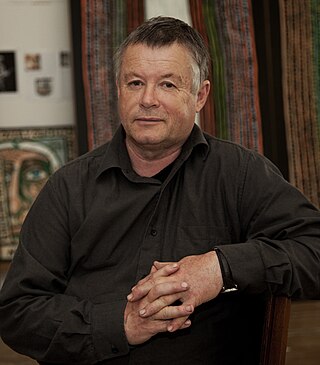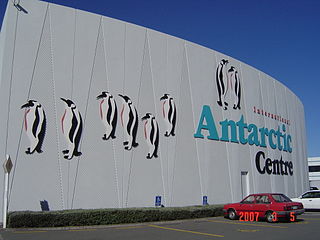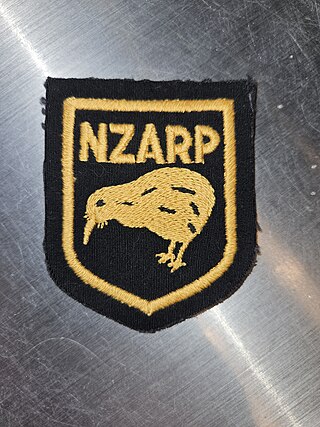Related Research Articles

Scott Base is a New Zealand Antarctic research station at Pram Point on Ross Island near Mount Erebus in New Zealand's Ross Dependency territorial claim. It was named in honour of Captain Robert Falcon Scott, RN, leader of two British expeditions to the Ross Sea area of Antarctica. The base was set up as support to field research and the centre for research into earth sciences, and now conducts research in many fields, operated by Antarctica New Zealand.

William Manhire is a New Zealand poet, short story writer, emeritus professor, and New Zealand's inaugural Poet Laureate (1997–1998). He founded New Zealand's first creative writing course at Victoria University of Wellington in 1975, founded the International Institute of Modern Letters in 2001, and has been a strong promoter of New Zealand literature and poetry throughout his career. Many of New Zealand's leading writers graduated from his courses at Victoria. He has received many notable awards including a Prime Minister's Award for Literary Achievement in 2007 and an Arts Foundation Icon Award in 2018.

Nigel Roderick Brown is a New Zealand painter living in Dunedin, New Zealand.

The Scientific Committee on Antarctic Research (SCAR) is an interdisciplinary body of the International Science Council (ISC). SCAR coordinates international scientific research efforts in Antarctica, including the Southern Ocean.

Multiple governments have set up permanent research stations in Antarctica and these bases are widely distributed. Unlike the drifting ice stations set up in the Arctic, the research stations of the Antarctic are constructed either on rocks or on ice that are fixed in place.

The International Antarctic Centre is a visitor attraction and public science discovery centre in the suburb of Harewood, Christchurch, New Zealand. It is located at Christchurch International Airport, adjacent to the buildings that are the Christchurch base for the Antarctic programmes of the US, New Zealand and Italy.

Timothy Raymond Naish is a New Zealand glaciologist and climate scientist who has been a researcher and lecturer at Victoria University of Wellington and the Director of the Antarctic Research Centre, and in 2020 became a programme leader at the Antarctic Science Platform. Naish has researched and written about the possible effect of melting ice sheets in Antarctica on global sea levels due to high CO2 emissions causing warming in the Southern Ocean. He was instrumental in establishing and leading the Antarctica Drilling Project (ANDRILL), and a Lead Author on the Intergovernmental Panel on Climate Change (IPCC) 5th Assessment Report (2014).
Many Antarctic research stations support satellite field camps which are, in general, seasonal camps. The type of field camp can vary – some are permanent structures used during the annual Antarctic summer, whereas others are little more than tents used to support short term activities. Field camps are used for many things, from logistics to dedicated scientific research.

The New Zealand Antarctic Research Programme (NZARP) was a research programme that operated a permanent research facility in Antarctica from 1959 to 1996. It was created by the Geophysics Division of New Zealand's Department of Scientific and Industrial Research (DSIR), originally based in Wellington. The programme promoted research in geochemistry, zoology, geology, botany, meteorology, and limnology.

Gareth Huw Morgan is a New Zealand businessman, economist, investment manager, philanthropist, public commentator and former political figure.
Raewyn Atkinson is a New Zealand ceramicist. She completed a Diploma in Early Childhood Education at the Palmerston North Teachers College in 1975 and a Bachelor of Arts in Art History at Victoria University of Wellington in 1998.

Anne Lysbeth Noble is a New Zealand photographer and Distinguished Professor of Fine Art (Photography) at Massey University's College of Creative Arts. Her work includes series of photographs examining Antarctica, her own daughter's mouth, and our relationship with nature.

Roberta Lee Farrell is emeritus professor at the University of Waikato, New Zealand and a researcher of international renown in the fields of wood degradation, bioremediation, mycology and enzymology.

Gillian Shirley Wratt is a New Zealand botanist and science administrator. She was the first woman director of the New Zealand Antarctic Programme (1992–1996) and made a Member of the New Zealand Order of Merit for services to Antarctica.
The Artists to Antarctica programme, also known as the Antarctica New Zealand Arts Fellowship and the Invited Artists Programme Antarctic Arts Fellows, was a community engagement programme run by Antarctica New Zealand, the government agency conducting New Zealand's activities in Antarctica.
Megan Lillian Jenkinson is a New Zealand photographer.

Niamh Shaw is an Irish scientist, engineer, STEM communicator, writer, and performer.
Laurence Fearnley is a New Zealand short-story writer, novelist and non-fiction writer. Several of her books have been shortlisted for or have won awards, both in New Zealand and overseas, including The Hut Builder, which won the fiction category of the 2011 NZ Post Book Awards. She has also been the recipient of a number of writing awards and residencies including the Robert Burns Fellowship, the Janet Frame Memorial Award and the Artists to Antarctica Programme.

Richard Levy is a New Zealand glacial stratigrapher and paleoclimatologist with expertise in microfossil analysis. As a principal scientist at GNS Science he has been involved in international and New Zealand environmental research programmes focussing on the evolution of the Earth's climate and building an understanding of the role of greenhouse gases in causing anthropogenic climate changes, in particular those impacting global sea levels. He has had extensive experience in scientific drilling, leading major projects, including the ANtarctic geological DRILLing (ANDRILL) Program in Antarctica. Since 2018, Levy has co-led the government funded NZ SeaRise programme.
References
- ↑ "Community Engagement Programme Participants and Arts Fellow Alumni". Antarctica New Zealand. Retrieved 14 November 2018.
- ↑ Press Release: Antarctica New Zealand (13 September 2017). "Antarctica: can you help us tell the story?". Scoop. Retrieved 14 November 2018.
- ↑ "Antarctica NZ calls for proposals to demystify science". Fuseworks Media. 30 November 2015. Retrieved 14 November 2018.
- 1 2 3 4 5 "Community Engagement Programme Alumni" (PDF). Antarctica New Zealand. Retrieved 16 August 2020.